Trim Castle
| Trim Castle | |
|
Meath | |
|---|---|
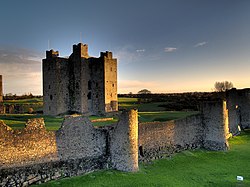 The keep and curtain walls of Trim Castle | |
| Location | |
| Grid reference: | N80245670 |
| Location: | 53°33’16"N, 6°47’23"W |
| Village: | Trim |
| History | |
| Built from the 12th century | |
| Key events: | Norman Ireland |
| Information | |
| Condition: | Ruin |
Trim Castle is a Norman castle on the south bank of the River Boyne in Trim in Meath. It is reckoned the largest Norman castle in Ireland.
The castle was built over a period of 30 years by Hugh de Lacy, Lord of Meath and his son Walter, to serve as the caput of the Lordship of Meath.
History
De Lacy
The castle was used as a centre of Norman administration for the Lordship of Meath, one of the new administrative areas of Ireland created by King Henry II of England.
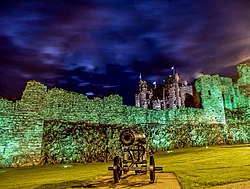
The site was chosen because it is on raised ground, overlooking a fording point on the River Boyne. The area was an important early mediæval ecclesiastical and royal site that was navigable in the Middle Ages by boat up the River Boyne, about twenty-five miles from the Irish Sea. Trim Castle is referred to in the Norman poem The Song of Dermot and the Earl.
Hugh de Lacy took possession of it in 1172. De Lacy built a huge ringwork castle defended by a stout double palisade and external ditch on top of the hill. There may also have been further defences around the cliffs fringing the high ground. Part of a stone footed timber gatehouse lies beneath the present stone gate at the west side of the castle.
De Lacy left Ireland entrusting the castle to Hugh Tyrrel, baron of Castleknock, one of his chief lieutenants. The ringwork was attacked and burnt by forces of the Gaelic High King of Ireland, Ruaidrí Ua Conchobair; Tyrrel, having appealed in vain for help, was forced to flee. Ua Conchobair soon withdrew and De Lacy immediately rebuilt the castle in 1173. His son Walter continued rebuilding and the castle was completed around 1224.
Geneville and Mortimer
The next phase of the castle's development took place at the end of the 13th century and the beginning of the 14th century; a new great hall (with undercroft and attached solar in a radically altered curtain tower), a new forebuilding, and stables were added to the keep.
On Walter de Lacy's death in 1241 his granddaughter Mathilda ('Maud') inherited the castle. Her second husband was Geoffrey de Geneville (brother of the historian Jean de Joinville), Lord of Vaucouleurs in Champagne, France, and of many lordships in England and Ireland which were to devolve upon his heirs. His son Piers de Geneville (who married Joan de Lusignan) died in 1292 leaving a daughter Joan, who in 1301 married Roger Mortimer (1st Earl of March).
Mathilda having died in 1304, in 1308 Geoffrey conveyed his Irish lordships to Roger Mortimer, and entered the priory at St. Mary's in Trim. Joan Mortimer inherited the title Baroness Geneville suo jure when Geoffrey died in 1314. The castle thereby passed to the Mortimer family who held it until 1425, when the male line died out with Edmund Mortimer, 5th Earl of March.[1] After this the estate passed to Richard of York, son of Edmund's sister Anne Mortimer by Richard of Conisburgh, 3rd Earl of Cambridge. Richard of York was killed at the Battle of Wakefield in 1460 but his son became King Edward IV, first of the House of York, and in 1461 King Edward appointed Germyn Lynch of London to be his representative at Trim.
Later ownership
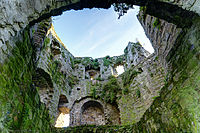
During the 15th century, the Parliament of Ireland met in Trim Castle seven times and a mint operated in the castle. It was at that time the centre of administration for Meath and marked the outer northern boundary of The Pale. In the 16th century it fell into decline and was allowed to deteriorate, but it was refortified during the Irish Confederate Wars in the 1640s. In 1649 after the sacking of Drogheda, the garrison of Trim fled to join other Confederate Irish forces and the place was occupied by the army of Oliver Cromwell.
After the wars of the 1680s, the castle was granted to the Wellesley family who held it until Arthur Wellesley (the Duke of Wellington) sold it to the Leslies. In following years it passed by way of the Encumbered Estates Court into the hands of the Dunsany Plunketts. They left the lands open and from time to time allowed various uses, with part of the Castle Field rented for some years by the Town Council as a municipal dump, and a small meeting hall for the Royal British Legion erected. The Dunsanys held the Castle and surrounds until 1993, when after years of discussion, Lord Dunsany sold the land and buildings to the State, retaining only river access and fishing rights.
Restoration
The Office of Public Works began a major programme of exploratory works and conservation, costing over six million euro, including partial restoration of the moat and the installation of a protective roof on the keep. The castle was re-opened to the public in 2000.
Structure
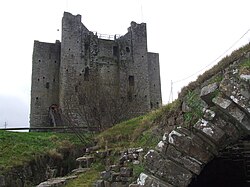
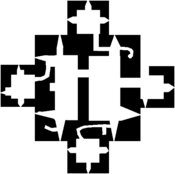
With an area of over 35,000 square yards, Trim Castle is the largest Cambro-Norman castle in Ireland. The design of the central three-storey keep (also known as a donjon or great tower) is unique for a Norman keep being of cruciform shape, with twenty corners. It was built on the site of the previous large ring work fortification in at least three stages, initially by Hugh de Lacy (c. 1174) and then in 1196 and 1201–5 by Walter de Lacy, Lord of Meath|Walter de Lacy.
The castle interior was partially the subject of archaeological digs, by David Sweetman of the Office of Public Works in the 1970s, and more extensively by Alan Hayden in the 1990s.
The surviving curtain walls are predominantly of three phases. The west and north sides of the enceinte are defended by rectangular towers (including the Trim Gate) dating to the 1170s; the Dublin gate was erected in the 1190s or early part of the 13th century; and the remaining wall to the south with its round towers dates to the first two decades of the 13th century.
The castle has two main gates. The one in the west side dates to the 1170s and sits on top of a demolished wooden gateway. The upper stories of the stone tower were altered to a semi-octagonal shape, c. 1200. The Dublin Gate in the south wall is a single round towered gate with an external barbican tower. It dates from the 1190s or early 13th century and was the first example of its type to be constructed in Ireland.
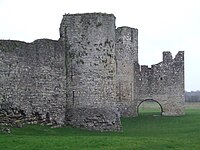
Apart from the keep, the main extant structures consist of the following: an early 14th-century three-towered fore work defending the keep entrance and including stables within it (accessed by a stone causeway crossing the partly filled-in ditch of the earlier ringwork); a huge late 13th-century three-aisled great hall (with an under croft beneath its east end opening via a water gate to the river); a stout defensive tower (turned into a solar in the late 13th century at the northern angle of the castle); a smaller aisled hall (added to the east end of the great hall in the 14th or 15th century); a building (possibly the mint) added to the east end of the latter hall; two 15th- or 16th-century stone buildings added inside the town gatehouse, 17th-century buildings (added to the end of the hall range and to the north side of the keep) and a series of lime kilns (one dating from the late 12th century, the remainder from the 18th and 19th centuries).
Access
Trim Castle grounds are open to the public, on payment of an entry fee, every day from Easter Saturday to 31 October from 10 a.m. Access to the Castle keep is via a 45-minute guided tour. In winter, the complex is open only on weekends and bank holidays.
Outside links
| ("Wikimedia Commons" has material about Trim Castle) |
- Meath Tourism on Trim Castle
- Trim Castle - Heritage of Ireland
- Translation of Grimm's Saga No. 10 The Ghost of Boyne Castle
References
- ↑ Duchas the Heritage Service (ed) (2002). Trim Castle Co. Meath. pp. 20–26. ISBN 0-7557-1282-X.
- Reeves-Smith, Terrence: 'Irish Castles' (The Appletree Press Ltd., 1995)
- De Breffny, Brian: 'Castles of Ireland' (Thames and Hudson, 1977)
- Salter, Mike: 'Castles and Stronghouses of Ireland' (Folly Publications, 1993)
- Sweetman, David: 'The Mediæval Castles of Ireland' (The Collins Press, 1999)
- McNeill, Tom: 'Castles in Ireland' (Routledge, 1997)
Further reading
- Sweetman, P. D. (1998), "The development of Trim Castle in the light of recent research", Château Gaillard: Etudes de castellologie médiévale XVIII: 223–230, https://books.google.com/books?id=lQ6AhnGOj2MC
- Hayden, A.R (2011) Trim Castle, Co Meath: Excavations 1995-8. Archaeological Monograph Series: 6. Wordwell (Bray) & Stationery Office (Dublin)
